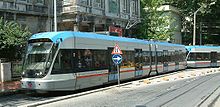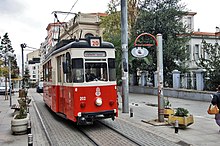İstanbul Ulaşım
The İstanbul Ulaşım Sanayi ve Ticaret A.Ş. Short Metro İstanbul , in addition to the İETT and İstanbul Otobüs AŞ one of the transport companies of the Turkish metropolis of Istanbul . It is in public hands.
The company, which was founded in 1988 in the course of the construction of the first modern subway line M1 , which at that time was still known as 'Hafif-Metro' (HM), has around 900 employees, and the number is rising. Istanbul Ulasim operates several rail-bound local transport systems in the metropolis, including the lines of the Istanbul Metro , the light rail line or 'Hafif Metro' , the tram lines , two cable cars and the underground funicular railway Füniküler . The first Istanbul underground railway on the European continent, the Tünelbahn , is maintained by İETT , as is the T2 tram line . The Istanbul S-Bahn is also integrated into the Istanbul Ulasim and İETT tariff association , although it is operated by the TCDD state railway .
General
İstanbul Ulaşım, like the other public transport companies, is tied to the city administration. With its transport offers, it achieved a high level of customer satisfaction of 76 percent. In 2005, which was UITP - Sustainability Charter signed. The aim and purpose of the company is v. a. to further expand the local rail transport in Istanbul in order to alleviate the massive problems of the metropolis in terms of air pollution, noise and traffic jams. To do this, the rapid transit network would have to be expanded to a distance of 505 kilometers. Istanbul Ulasim is working to achieve this goal under the direction of the government and the city administration by 2023, the 100th anniversary of the republic .
To this end, the metro will also be gradually expanded. Because at the beginning of the 1990s, the rail-bound public transport network was very modest for the city, which at that time already had almost seven million inhabitants. Up until the 1980s, Istanbul's city administration relied entirely on individual transport , which was a sign of modernity , and tried to make the city more car- friendly. In the course of this, the tram network operated until 1961 (European side) and 1966 (Asian side) was discontinued, which once consisted of 19 lines. Only the city bus system and the network of city ferries remained in addition to the minibus lines. In 1966, the only rapid transit system in Istanbul was the S-Bahn network with its two suburban lines running along the seashore in the south of the city and separated by the Bosporus .
Reconstruction of a rail network
When the first metro line was built in 1989, Istanbul already had over 6.5 million inhabitants. Ten years later there were 8 million; then in 2000 - with the opening of the second underground line - almost 14 million. Due to unexplained and not clearly delimited responsibilities in administration and archaeological finds that had to be recovered, the underground and suburban railway construction progressed more slowly than desired.
So far there is mainly a gap in the merger of the M1 and M2 metro lines with the Marmaray S-Bahn in Yenikapı. A new central station is being built there with the possibility of transferring local and long-distance rail traffic between the European and Asian sides.
Lines from Istanbul Ulasim
metro
| Lines from Istanbul Ulasim | |
|---|---|
| Metro lines : M1 A | M1 B | M2 | M3 | M4 | M5 (under construction) | M6 | M7 (under construction) | | |
| Tram lines: T1 | T3 | T4 (Hafif Metro) | |
| Funiculars: F1 | Tünelbahn | |
Istanbul Ulaşım operates the six metro lines M1 A , M1 B , M2 , M3 and M6 (on the European side of the city) and the M4 on the Asian side. In addition, two more lines are under construction: These are the new M5 line on the Asian side, which runs from Üsküdar to the east, and the M7 line on the European side of the city north of the Golden Horn. The M5 and M7 are scheduled to go into operation in 2017.
Line symbol of the M1 A
Line symbol of the M1 B
Line symbol of the M2
Line icon of M3
Line symbol of the M4
Line symbol of the M6
Metro lines under construction
Metro lines in planning
Line symbol of the M8
Stadtbahn or 'Hafif Metro'
The Hafif Metro Istanbul is a light rail in the west of Istanbul. In Turkish, Stadtbahn means “Hafif Metro”, literally translated as “light subway”. The system consisted of lines M1 and T4 . For a long time, today's M1 underground line was counted as part of the Hafif Metro, as the same light rail vehicles are used on it as on the T4. In addition, the M1 also has a power supply with overhead lines . Since it runs free of intersections and is independent of road traffic, it has been called M1 for several years and is part of Istanbul's subway system.
The T4, on the other hand, is also designated in its line number with the T for "Tramvay" because it is a light rail . Seven stations of the line are underground stations, the other 15 are tram stops. The T4 runs almost exclusively on a separate track. Nevertheless, pedestrians can cross the route and there are intersections with road traffic and traffic lights. At the Topkapı stop, there is a transition to T1 and the metrobüs system operated by İETT .
Tram or 'Tramvay'
The modern tram lines T1 (tram) and T4 (light rail)
There are four tram lines, the lines T1 , T3 and the line T2 (formerly T5) operated by the İETT. With the merger of T1 and T2 in Zeytinburnu, T2 was abandoned. The T4 line is also officially called the tram line, but has the character of a 'Hafif Metro'.
The T1 tram line runs right through historic Istanbul (route length almost 20 kilometers). It is therefore not only an important commuter connection for the western suburbs to the old town and with transfers to the modern center ( Beyoğlu , Taksim ). Rather, it is particularly interesting from a touristic point of view, as several well-known sights ( Hagia Sophia , Blue Mosque , Grand Bazaar , Yerebatan Sarnıcı , Topkapı Palace ) are located at T1. The opening took place on June 13, 1992 on the Beyazıt - Yusufpaşa section. The line was extended in several sections to the Zeytinburnu district (January 31, 1994). The extension from Sirkeci station to Eminönü (April 20, 1996) and then on to Kabataş also brought the connection via the new Galata Bridge to the districts north of the Golden Horn. Since February 4, 2011, line T1 has continued from Zeytinburnu to Bağcılar; this integrated the former T2 line from Zeytinburnu to Bağcılar.
The nostalgic tram lines T3 and T2 (formerly T5)
Tram line T3 is a museum tram between Kadıköy and Moda in the Asian part of the city. It opened on November 1, 2003. It is a one-way, 2.6 kilometer long ring route that follows an impressive course through the hilly and narrow streets of the district. The route is served by various Gotha ( T57 , T59 ) and Reko cars (TZ 70) originally from the GDR , almost all of which were taken over by the Jena local transport company. The line designation 20 can be read on the vehicles (but this is not the official line designation).
The museum tram T2 (formerly T5) in Beyoglu (Turkish: Nostaljik Tramvay ) is operated by the IETT. It connects Taksim Square with Tünel and its route goes through the famous central shopping street İstiklal Caddesi .
Funicular
The F1 funicular line goes from Kabataş on the Bosphorus up to Taksim Square . This funicular, which runs completely in the tunnel, was opened on June 30, 2006 and connects the end points, which are about half a kilometer apart, in 110 seconds. Until a direct change from the M1 to the M2 is possible in Yenikapı, the F1 represents an important connection between the Istanbul rail systems, also for passengers of the M1 and T4 from the western and north-western parts of the city. So far, these have been increasing to the modern center ( Beyoğlu / Taksim), in Aksaray switch to T1 in the direction of Kabataş. The F1 connects the terminus of the T1 in Kabataş with the Taksim station, where the M2 and T2 lines (formerly T5) depart.
The funicular F3 ( Vadistanbul Havaray ) connects Sayrantepe with Vadistanbul and, in contrast to the F1 and the Tünel (F2), runs above ground.
Cableways
There is also a cable car between Maçka Parkı and Harbiye Parkı, as well as one that runs between Eyüp and Piyer Loti / Pierre Loti .
Tariff system and fares
The same tariff system applies to the means of transport of the three urban transport companies in Istanbul, i.e. Istanbul Ulasim, İETT and İstanbul Otobüs AŞ . You can pay with special tokens , the Akbil pass or the Istanbulkart. The latter systems work with electronic debiting from previously charged storage media.
For each trip, tokens must be redeemed and placed in the slot at the locks so that the barriers or turnstiles are released for the person paying. A token costs 4.00 TL .
Electronic pre-paid systems
The Akbil Pass - the word is an acronym from "akıllı" (Turkish. Smart) and "bilet" (Turkish. Ticket) - is a discount payment system with a price of 2.15 TL per trip decreased.
The second electronic debiting system is the Istanbulkart . In addition to a regular version of the card, there are three types of discount cards. The fare is debited electronically by contactless readers when passing through the barrier systems or on the buses. A payment with the card on a reader allows passengers to change five times within two hours between the lines of all means of transport in the tariff association. The card replaces cash transactions in all modes of transport (city bus, tram, metro, light rail, cable cars, suburban trains and ferries). After paying a deposit of 10 TL, a maximum of 150 TL can be loaded. The cards are available at the counters in the customer centers of the local transport companies.
Discounts
For certain groups of people such as B. Pensioners, civil servants and schoolchildren there are reduced tariffs, they pay 1.00 TL per trip.
Web links
Individual evidence
- ↑ a b İstanbul Ulaşım: Tarihçe
- ↑ İstanbul Ulaşım: Raylı Sistemler ( Memento of the original from April 9, 2014 in the Internet Archive ) Info: The archive link was inserted automatically and has not yet been checked. Please check the original and archive link according to the instructions and then remove this notice.
- ↑ a b c Urbanrail.net: İSTANBUL
- ↑ a b İstanbul Ulaşım: Ücret Tarifeleri
- ↑ Online appointment ( memento of the original from September 16, 2012 in the Internet Archive ) Info: The archive link was inserted automatically and has not yet been checked. Please check the original and archive link according to the instructions and then remove this notice.
- ↑ İstanbul Ulaşım: Seyahat Kartları



























